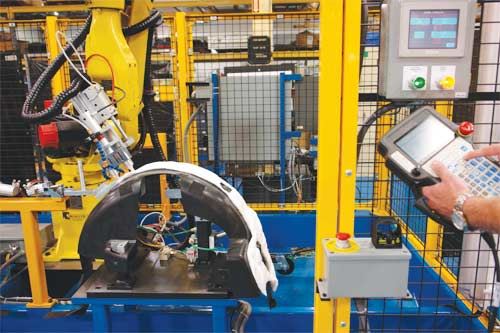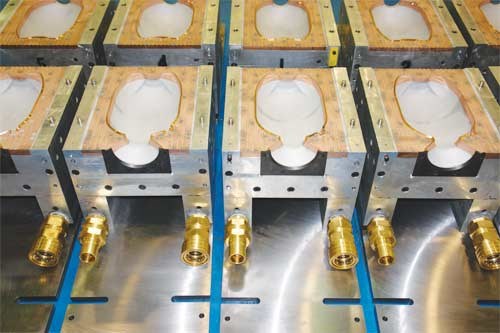Automation Division Paves Way to New Customers
Ohio-based FPM Tooling and Automation found new unconventional markets when it launched a division focused on automotive.
FPM Tooling and Automation (Fremont, OH)—a manufacturer
of CNC-cut molds, tooling, gages and downline finishing equipment (including robot cells, sonic welding, hot knife and trim cells)—has devised some innovative strategies to expand its business and land new customers. The company’s addition of an automation division actually paved the way for FPM President Martin Cass to make the call to sell his company’s products on EBay.
The company started out in 1969 primarily as a supplier of cast aluminum tooling to the industrial blow mold, rotational and thermoform industries. Ten years ago, Cass started to take the company in a new direction by manufacturing and supplying its customers with finishing equipment and check gages. “It then started to make sense to look at expanding that division,” Cass recalls. “By 2006, we were ready to step up our game and worked to acquire the people and skill sets needed to manufacture more technical robot, PLC (Programmable Logic Control) and vision equipment (high res digital photography that can be used to reference and check components and parts). Although most of my existing employees had loads of CAD/CAM experience with tremendous mechanical background, I required a slightly different flavor of technical ability. From here I believed that we could work with our existing guys to program and build machines rather than program and build molds. It was a hit. We received intense training from Fanuc, brought in enough experienced people to change the flavor of the company and we all enjoyed the challenge of working to support an entire work cell—rather than seeing a small part of a program.
“During this changeover period our product mix has altered significantly as a result of molds being manufactured overseas,” Cass continues. “But we have supported our facility and customers by improving our one-stop shop program management philosophy—and we now supply molds along with automation equipment, and support the entire processing work cell.”
Marketing Savvy
To launch FPM’s automation division, Cass called upon past experience. “During the late ‘90s FPM belonged to the Midwest Tooling Group, and I had been involved with researching and acquiring companies for sale,” Cass explains. “During this time our group had looked at a few different downline equipment companies. With a vision of raising our game, Kenny Recker (who heads up our downline equipment division) and I pursued a few of the companies that we had spoken to back then, and we found a match—a company in Toledo that was under pressure in the North American manufacturing turmoil, but had the technical employees we needed to raise our level of competence in this field. We discovered we could take advantage of local training dollars and sent a group of our employees to Fanuc robot training. So far it has been a great fit.”
FPM devised its own method to spread the word about its new capabilities. “Once we have a new idea, we then produce a piece of marketing literature that includes commentary and photos of something that we think may help our customers,” Cass explains. “It may be our hot plate welding capacity or most recently a new cutter that we have developed to trim flash from blow-molded parts at the end of a robot arm. We broadcast out to a database of people, and/or sometimes print and send hard copy post cards. From there the creation becomes part of our company presentation; we add it to our website, to our promotional printed literature and maybe our catalog.”
To date, the automation division comprises 50 percent of the company’s business, with the other half moldmaking. “Our program managers are able to gather more intelligent information now,” Cass comments, “and we understand more about what our customers are trying to achieve, and that makes us a better supplier. Under the traditional moldmaker scenario we would get to see a program through the mold and not completely understand how it would finish or fit into an assembly or finishing sequence—for example labeling, quality checking, any sonic welding or spin welding with certain criteria that may be necessary to prepare for. Our abilities today enable us to see those areas and prepare for them in the mold design. We are able to make suggestions about alternative finishing methods or in some cases alter the mold to offer a particular finishing application. Now we find the program managers and designers become more aware of the consequences down line—therefore improving their outlook.”
Cass plans on this expanded knowledge of FPM’s customer base to carry the company into the future. “Part of our vision was to try and look at what will happen to American manufacturing,” he states. “We see that better automation and more productive work cells will enable U.S. manufacturing companies to be competitive on a global level. We have tried many new avenues to grow business through the years, and we encourage a culture of flexibility and change. Every team is different. We believe that supporting our team will help them maintain confidence no matter how bad things are. The marketplace still has lots of challenges, but little by little we are seeing improvement. The U.S. will pull through and be stronger.”
Related Content
Laser Welding Versus Micro Welding
The latest battle in finely detailed restoration/repair of mold materials.
Read MoreAdvantages and Disadvantages of Copper and Graphite Electrodes
Both copper and graphite provide approximately the same end result, so it is important for a shop to consider the advantages and disadvantages of each material in order to discover what would work best in their shop floor environment.
Read MoreHow to Eliminate Chatter
Here are techniques commonly used to combat chatter and guidelines to establish a foundation for optimizing the moldmaking process.
Read MoreForces and Calculations Are Key to Sizing Core Pull Hydraulic Cylinders
To select the correct cylinder, consider both set and pull stroke positions and then calculate forces.
Read MoreRead Next
How to Use Strategic Planning Tools, Data to Manage the Human Side of Business
Q&A with Marion Wells, MMT EAB member and founder of Human Asset Management.
Read MoreAre You a Moldmaker Considering 3D Printing? Consider the 3D Printing Workshop at NPE2024
Presentations will cover 3D printing for mold tooling, material innovation, product development, bridge production and full-scale, high-volume additive manufacturing.
Read MoreReasons to Use Fiber Lasers for Mold Cleaning
Fiber lasers offer a simplicity, speed, control and portability, minimizing mold cleaning risks.
Read More










.png;maxWidth=300;quality=90)





_300x250 3.png;maxWidth=300;quality=90)











